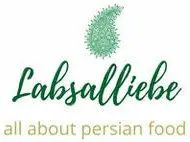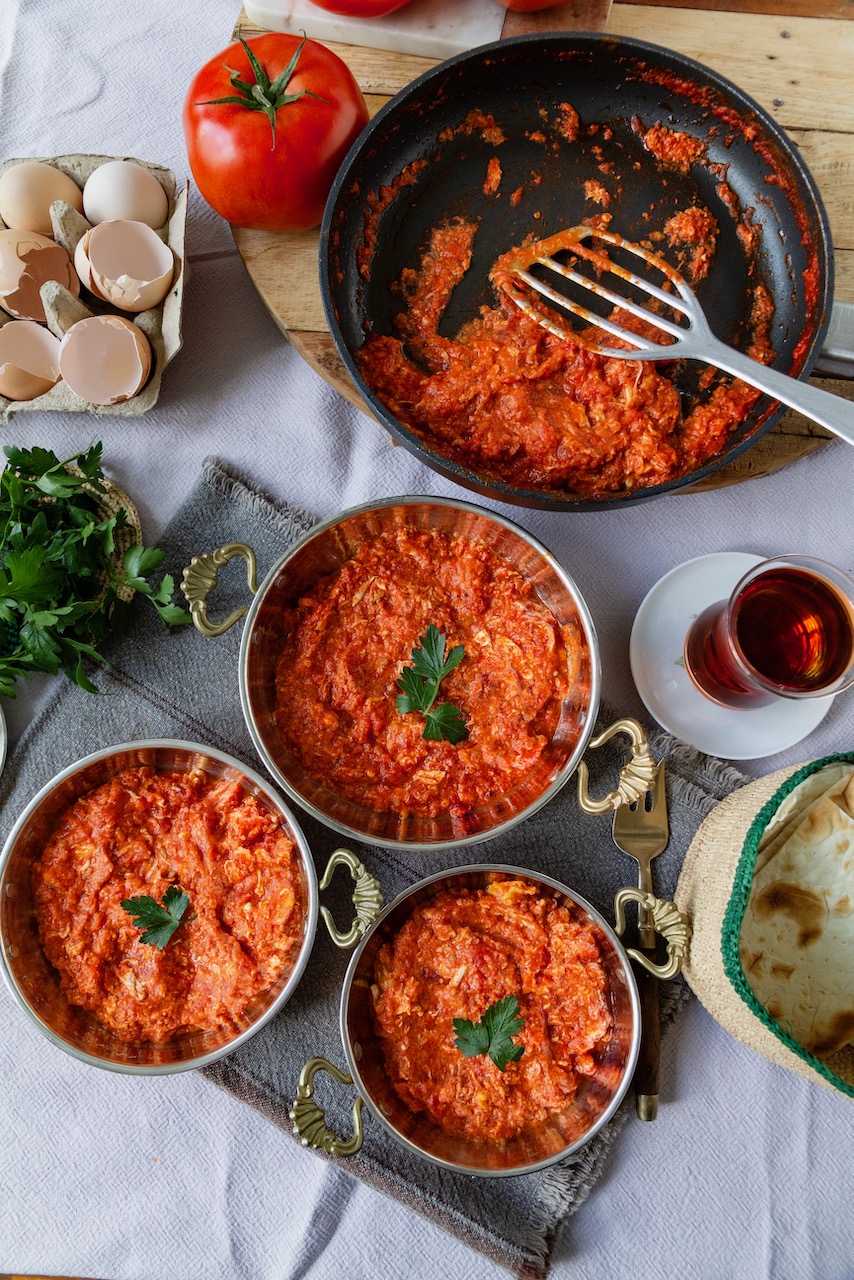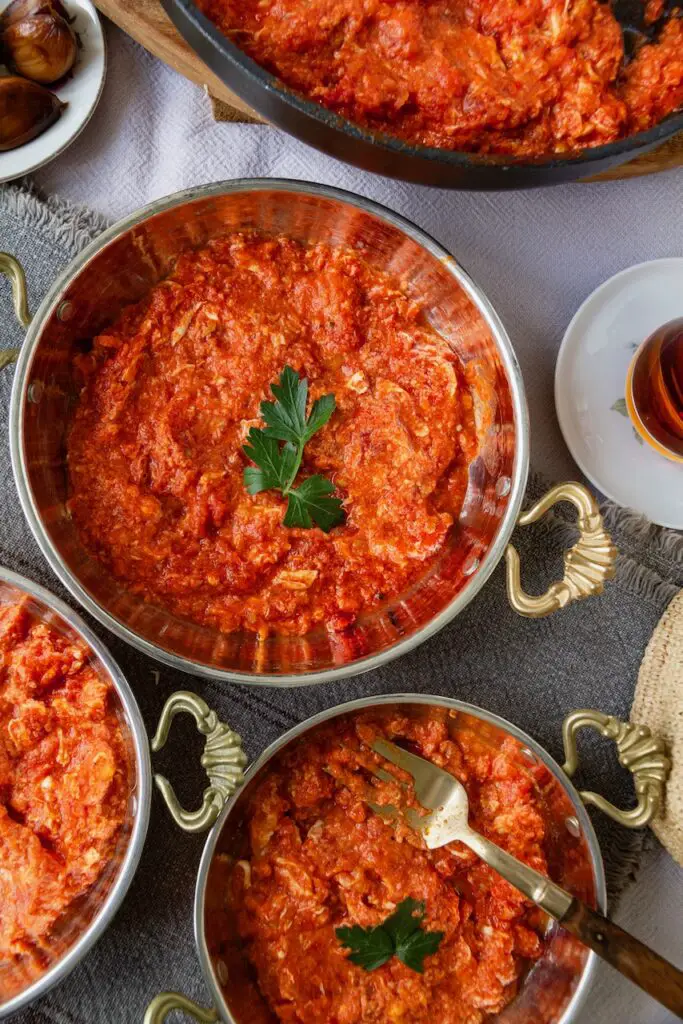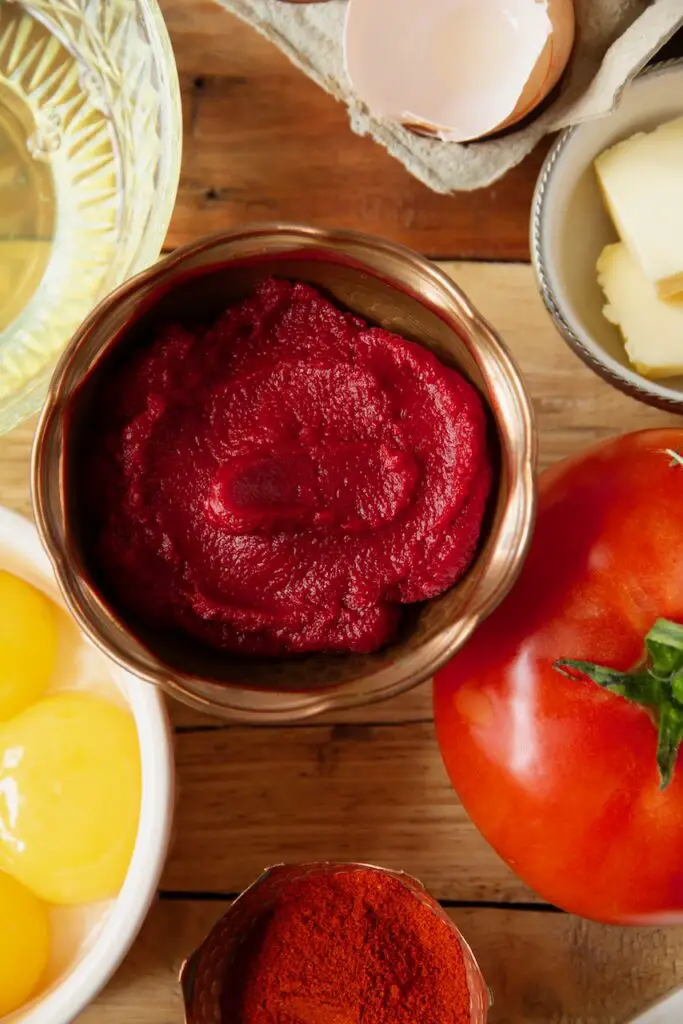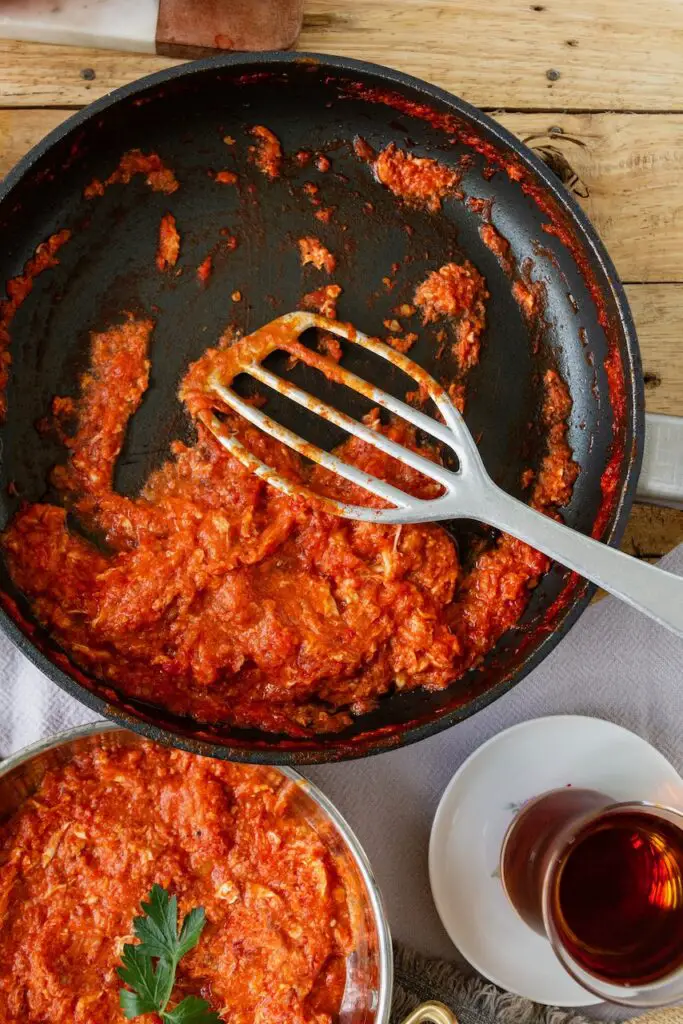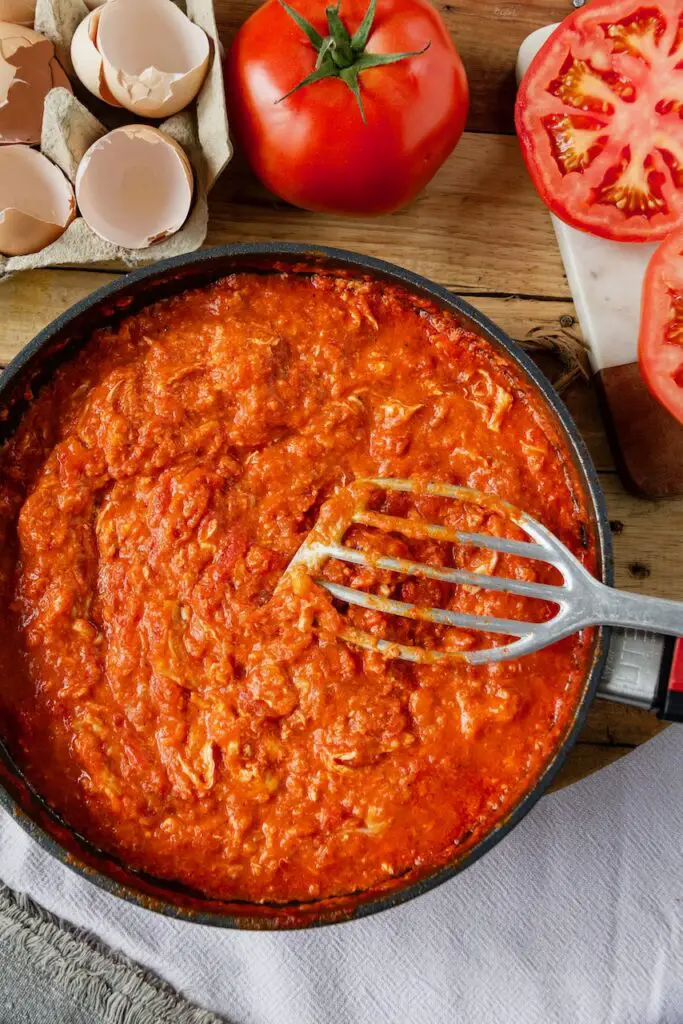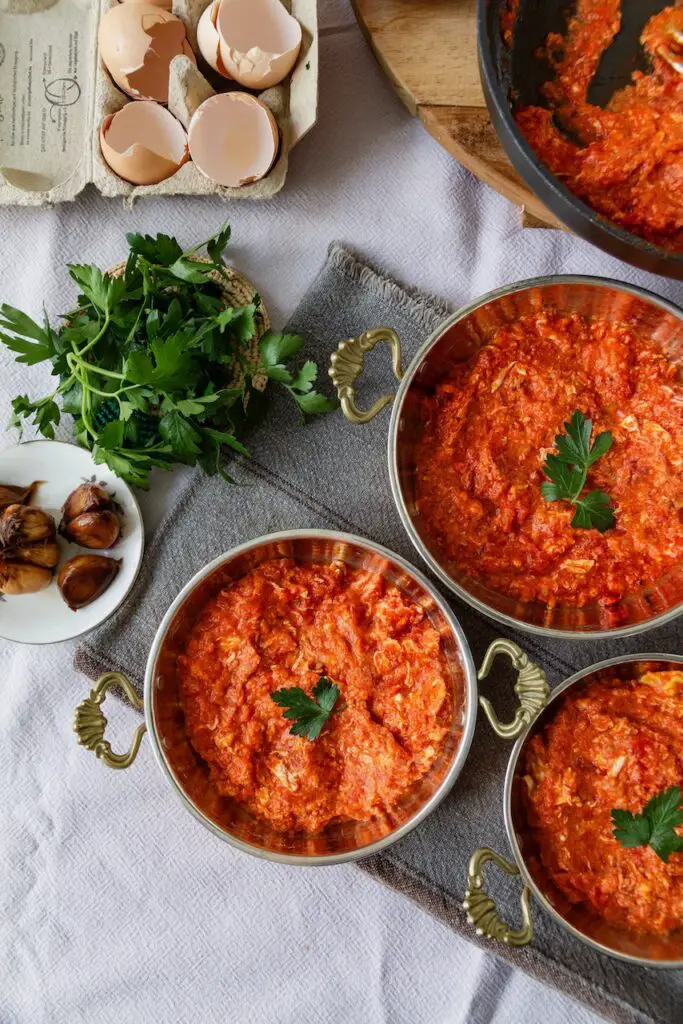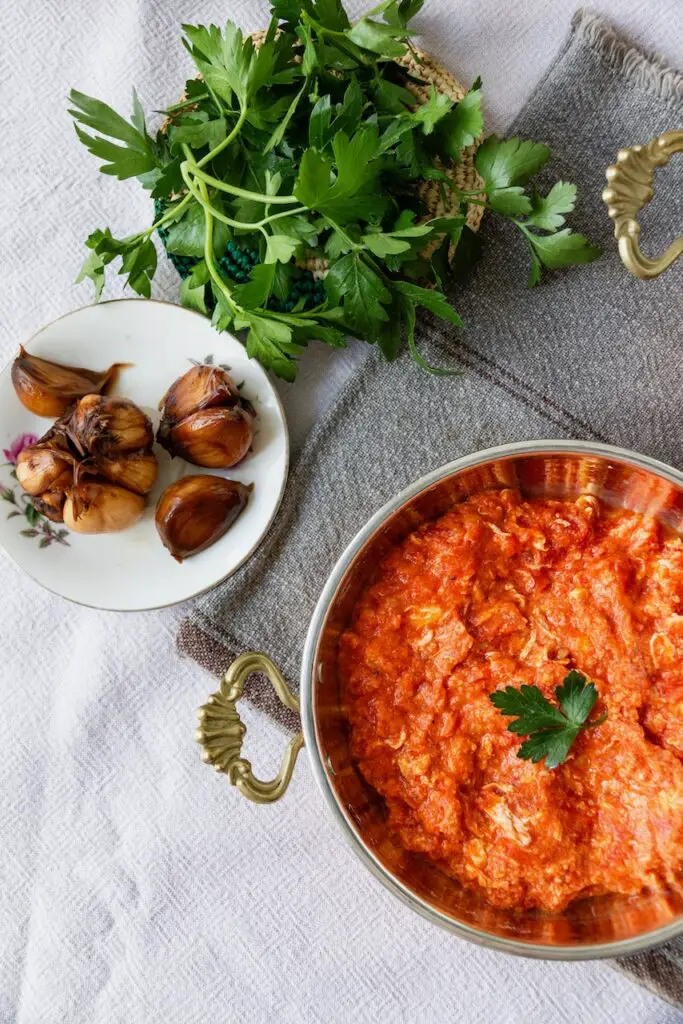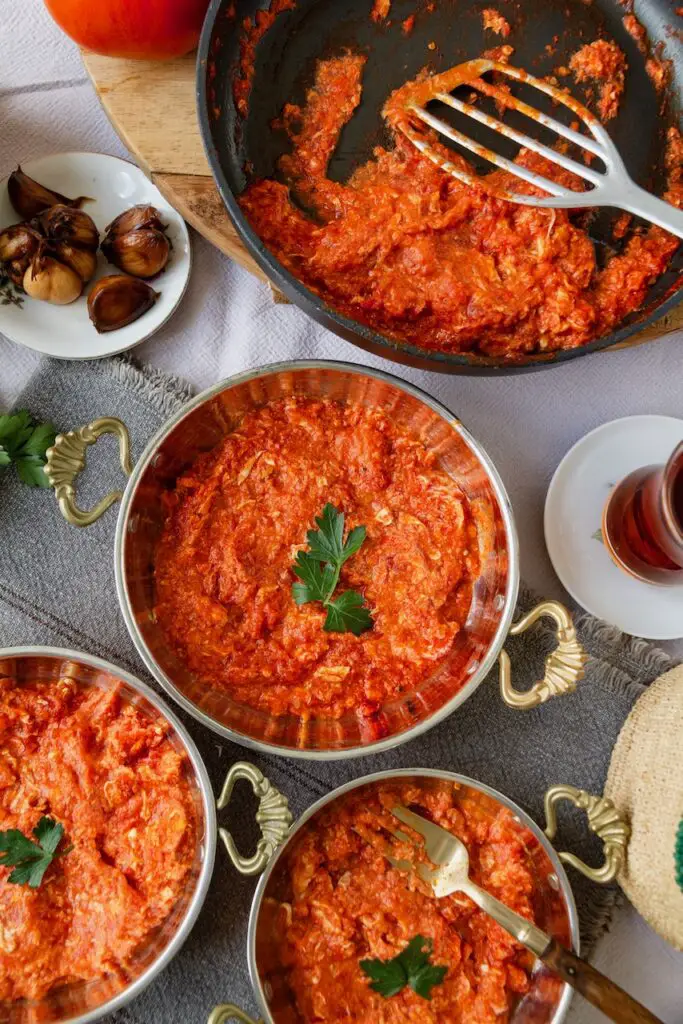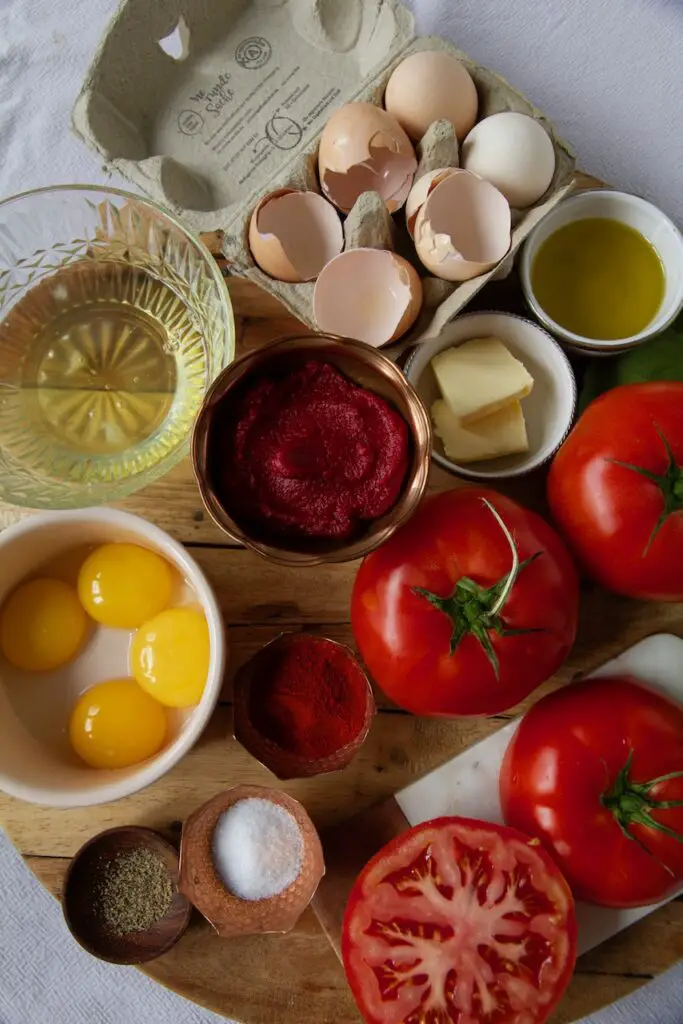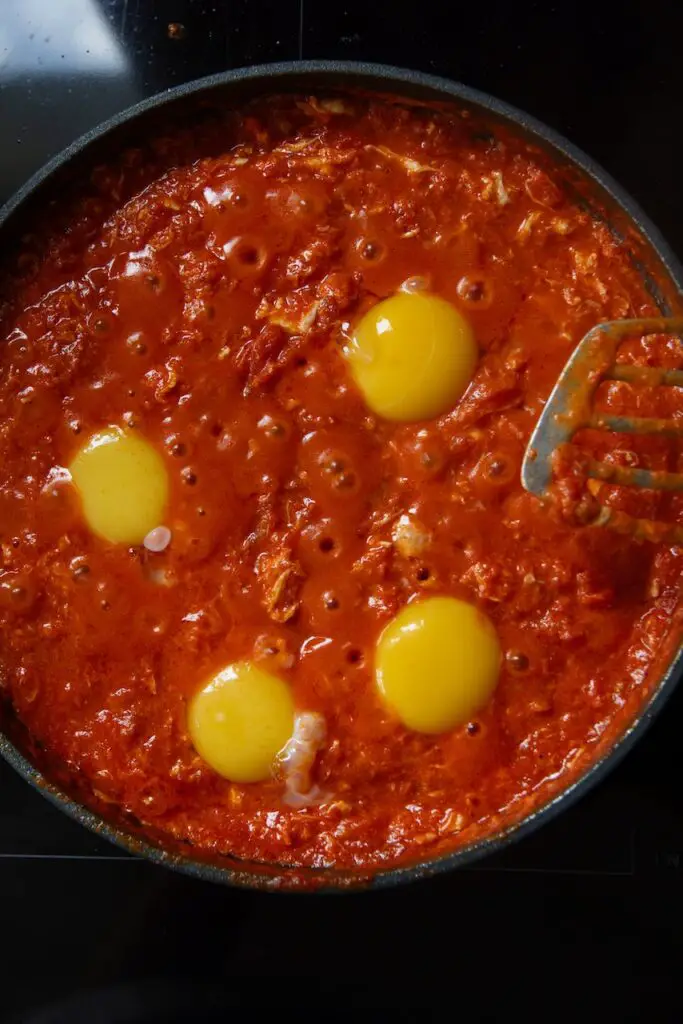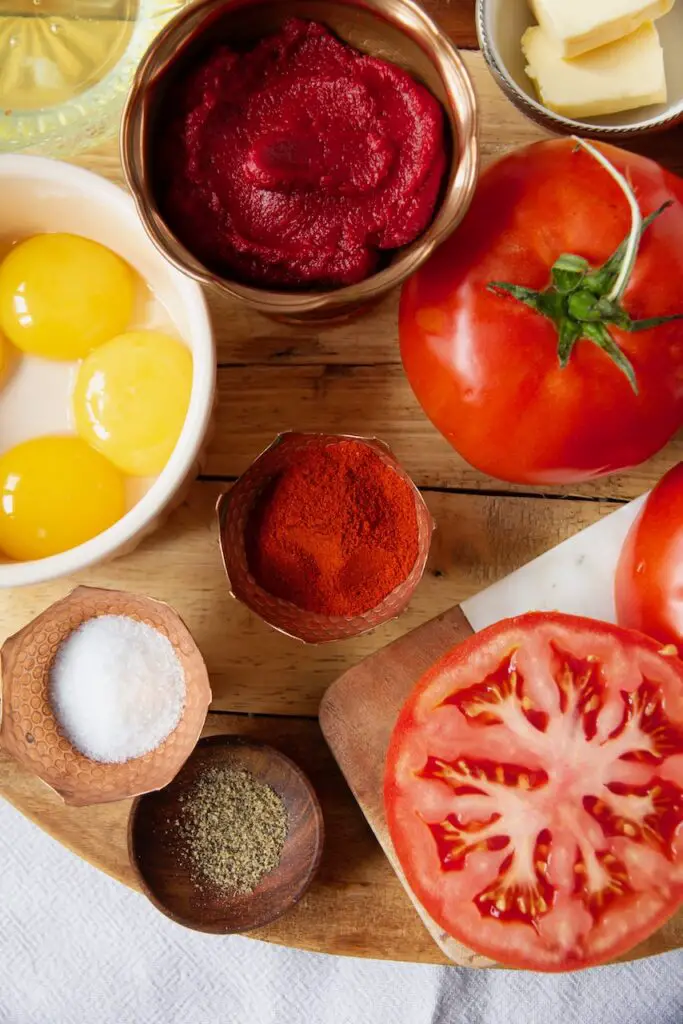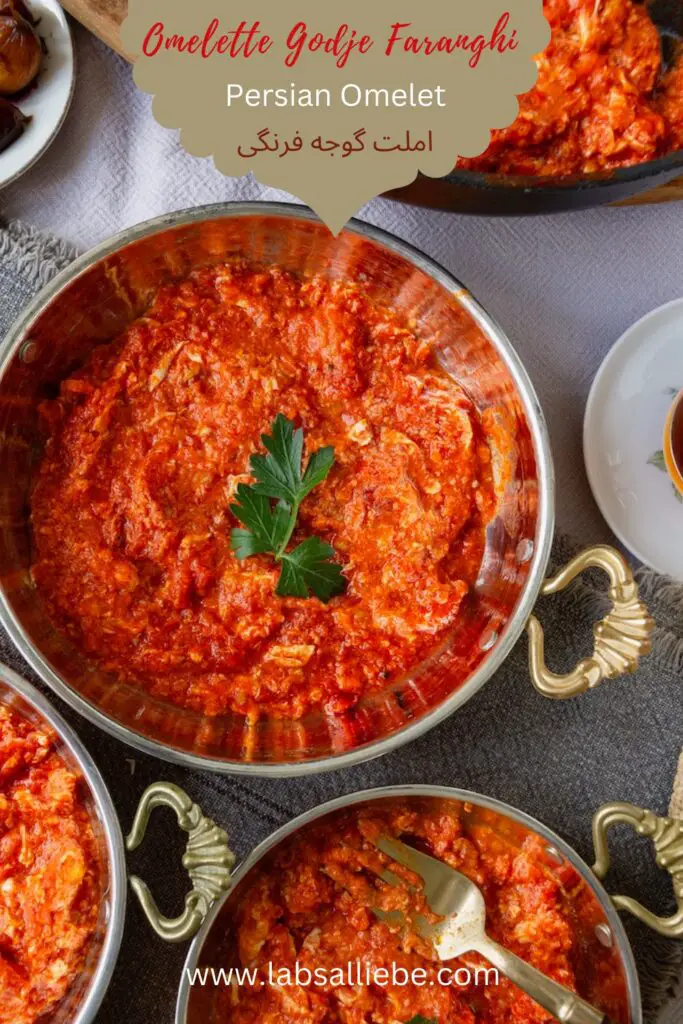Today I am serving a savory breakfast – a classic, trendy Persian dish called Omelette Godje Faranghi – Persian Omelet املت گوجه فرنگی. In Persia, omelet means a dish with eggs, but it’s quite different from the omelets you may know from Germany, France, or Italy. To prepare persian omelet we use scrambled eggs with fried tomatoes, tomato paste, and spices. We serve it with hot Persian tea, fresh herbs, sir torshi (pickled garlic), fresh traditional Nan-e Lavash, Nan-e Barbari, Nan-e Taftoon, or Nan-e Sangak. Omelet is also often enjoyed with simple steamed rice. So, roll up your sleeves, switch on the stove, and heat the pan to make a delicious breakfast. Enjoy your meal!
watch my preparation video on Instagram
OMELETTE GODJE FARANGHI – PERSIAN OMELET املت گوجه فرنگی
A healthy, high-protein breakfast is the perfect way to start the day with energy. Eggs contain a lot of protein, which prevents cravings during the morning and keeps you feeling full. Sometimes, a quickly prepared omelet is the best choice for a quick breakfast. The Persian omelet is also great for brunch, lunch, or dinner. Prepare your omelet with organic eggs, fresh tomatoes, and you’ll love it.
The Persian omelet is best enjoyed with seasonal tomatoes, which are readily available in the summer. However, you can prepare the omelet all year round as fresh tomatoes are always available. The tomatoes add juiciness to the scrambled eggs. Some people also use grated fresh tomatoes, but I prefer to cut them in half and steam them in the pan. Sometimes, the omelette is also prepared with onions and/or garlic.
WHAT DO IRANIANS EAT FOR BREAKFAST?
During the week, breakfast in Iran is usually simple, but having breakfast with the family on weekends is a joy. Here you can find some more Persian breakfast ideas. A delicious pan of Persian omelet brings back many childhood memories to most Iranians. I remember our sleepovers at my aunt’s house, spending the night on the flat roof under the stars and waking up in the morning to the tantalizing smell of freshly baked bread.
My aunt spread the sofreh (tablecloth) on the floor and covered it with feta cheese, walnuts, sabzi khordan, butter or clotted cream, and some of my grandma’s homemade jams, such as Morabaye Chagale Gerdoo – Green Walnut Preserves – مربای گردو, Morabayeh Gol – Persian rose petal jam, and Morabay-e Toot Faranghi – strawberry jam. Of course, my absolute favorite, a delicious pan full of omelet, was also placed in the middle of the sofreh and served with a cup of hot Persian tea. Omelette is not only a wonderful start to the day, but also a journey back to the traditional flavors of Persia.
PERSIAN GHAHVEH KHANEH
Since the 16th century, Ghahveh Khanes have been a popular gathering place in Iran for poets, writers, artists, and people from the upper classes. Originally, it was a place to enjoy a cup of coffee, have conversations, and play chess or backgammon. Over time, Iranians shifted from drinking coffee to tea, but the name Ghahveh Khaneh persisted even though coffee was no longer served there. As a result, it is sometimes referred to as Chai Khaneh (tea house) today.
When in Iran, be sure to visit Ghahveh Khaneh-ye Sonnati, a traditional coffee house. The architecture of these places is gorgeous. Most of them are large halls with a houz (water basin) in the middle, which cools and moisturizes the room. The ceilings are often arched or have domes that are skillfully decorated. This form of architecture also cools the room and gives a feeling of openness and majesty. Doors, window frames, and other wooden elements are decorated with detailed patterns and carvings that reflect traditional Persian craftsmanship.
In the central area, there are high platforms known as takhts, which are used as seating areas. These platforms come in different sizes, depending on the size of the coffee house. Guests sit on carpets or cushions spread out on these platforms. The walls are often richly decorated with floral tilework, paintings, and tapestries. Ghahve Khaneh paintings are particularly typical, depicting stories from Persian folklore, epic tales, and historical scenes.
OMELETTE GHAHVEH KHANEI
Let’s talk about omelette Ghahveh Khanei! This savory dish is not just for breakfast but is also available all day in restaurants and Ghahveh Khane (coffee houses). The recipe I’m making today is based on the traditional Ghahveh Khanei omelet, also known as Omelette Restorani, which is served in Persian tea and coffee houses. The owners of these traditional cafes are careful not to waste any eggs that might stick to the pan. The café chefs use grated tomatoes, and here’s how they do it: first, they pour the egg white into the middle of the pan and stir it until it sets. Then they add the egg yolk, but they don’t stir it until it’s also set, and then mix it with the rest of the ingredients in the pan. This prevents egg scraps from sticking to the pan.
OMELET VERSIONS
The Persian omelet was introduced and popularized in various cities of Iran by famous coffee and tea houses. The Iranian version of the omelet is prepared differently depending on the region. There are countless recipes, and listing them all would be too long, so here are just a few very popular versions.
Omelet ba Rob: This dish features scrambled eggs with tomato paste. Most Persians across Iran prefer using tomato paste at home and skip the grated tomatoes.
Omelet Khorma: Try the date omelet, a speciality made with dates from the south of Iran, with a dash of cinnamon and perhaps saffron. You can find my recipe here.
Omelet Shahpouri or Loobia Rashti: A delightful dish of eggs with beans, this specialty resembles English breakfast beans and eggs and is served on the Caspian Sea in the north of Iran. You can discover my recipe for the classic Persian loobia chiti – Persian beans here.
Nargesi: Nargesi is sautéed baby spinach with fried eggs and is also known as “Gol dar Chaman”, which means “flowers in the meadow” in Persian. The name is inspired by the resemblance of a fried egg to the narcissus flower.
Baghali Gatogh: It’s a delightful omelet made with Persian broad beans, garlic, turmeric, fresh dill, and eggs, hailing from the north of Iran.
Kuku: Kuku dishes are mostly vegetarian egg dishes from Persian cuisine, typically prepared with various herbs or vegetables, although they can also contain meat or fish. They are similar to Italian frittatas, Spanish tortillas, or Arabic eggah.
Khagineh: This is a simple yet flavorful Middle Eastern pancake bursting with oriental flavors. It’s a must-try for all Middle Eastern food lovers! Find my recipe here.
LECKERES FÜR JEDEN TAG – ALLES FÜRS FRÜHSTÜCK
Attention please! It’s time for another “Leckeres für jeden Tag” blog event, which takes place on the first Sunday of every month. This time, our theme is “Everything for Breakfast”. A delicious breakfast is the perfect way to start your day, whether it’s with fresh croissants, fluffy pancakes, jam, or a tropical treat – we have it all! Let this event inspire you and kickstart your day with a breakfast that will bring a smile to your face. All recipes are in German.
Britta von Backmaedchen 1967 mit Schnelle Quarkbrötchen
Bettina von homade & baked mit Overnight Oats mit Beeren
Carina von Coffee2Stay mit Tropischer Genuss zum Frühstück
Regina von Bistroglobal mit Bagels
Caroline von Linal’s Backhimmel mit Schokoladen Babka
Kathrina von Küchentraum & Purzelbaum mit Einfaches Breakfast Board
Cornelia von SilverTravellers mit Dutch Baby – der einfache Pfannkuchen aus dem Ofen
Sonja von fluffig & hart mit Mon Chéri Marmelade
Simone von zimtkringel mit Breakfast Egg Muffins
Britta von Brittas Kochbuch mit Schinken-Käse-Croissants
Bianca von ELBCUISINE mit Pain d’Épi – das einfache Baguette-Rezept perfekt auch als Backmischung zum Verschenken!
Sylvia von Brotwein mit Laugenknoten Rezept – formen und seber backen
Silke von Blackforestkitchen mit Mini-Pancakes-Bowl
Tina von Küchenmomente mit Mohnflesserl
INGREDIENTS PERSIAN OMELET
2 large beef tomatoes, halved
2 tbsp tomato paste*
20 g butter*
2 tbsp olive oil*
1 tsp paprika*, sweet
salt, pepper
1 tbsp lemon juice, freshly squeezed (optional)
4 eggs, separated
PREPARATION PERSIAN OMELET
Halve the tomatoes and place them cut side down in a hot pan. Add a little water and cook for 3-4 minutes until the skin comes off by itself. Remove the skin and mash the tomatoes with a meat masher.
Add the tomato paste, stir it all together, and cook for a further 2-3 minutes.
Add the seasoning: paprika, salt, pepper, and freshly squeezed lemon juice (optional). Mix well.
Stir in the butter and olive oil.
Separate the eggs and add the egg whites to the pan first. Allow them to set, stirring constantly. As soon as the egg whites have set, add the egg yolks, wait a minute, and continue stirring.
Enjoy this simple and delicious Persian omelet with a hot cup of tea and fresh lavash bread.
BEFARMAYID!
Susan
The items marked with * are affiliate links, referral links. If you buy through this link, I get a small commission. The price stays the same for you and you can easily support my efforts. A big thank you ♥
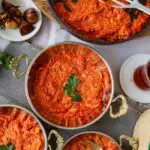
Omelette Godje Faranghi – Persian Omelet املت گوجه فرنگی
A classic and popular persian breakfast
Ingredients
INGREDIENTS PERSIAN OMELET
- 2 large beef tomatoes halved
- 2 tbsp tomato paste
- 20 g butter
- 2 tbsp olive oil
- 1 tsp paprika sweet
- salt pepper
- 1 tbsp lemon juice freshly squeezed (optional)
- 4 eggs separated
Instructions
PREPARATION PERSIAN OMELET
-
Halve the tomatoes and place them cut side down in a hot pan.
-
Add a little water and cook for 3-4 minutes until the skin comes off by itself.
-
Remove the skin and mash the tomatoes with a meat masher.
-
Add the tomato paste, stir it all together, and cook for a further 2-3 minutes.
-
Add the seasoning: paprika, salt, pepper, and freshly squeezed lemon juice (optional). Mix well.
-
Stir in the butter and olive oil.
-
Separate the eggs and add the egg whites to the pan first. Allow them to set, stirring constantly.
-
As soon as the egg whites have set, add the egg yolks, wait a minute, and continue stirring.
Recipe Notes
Enjoy this simple and delicious Persian omelet with a hot cup of tea and fresh lavash bread.
Save the recipe for later on Pinterest!
Have you cooked this or maybe another delicious recipe of mine? Feel free to leave me a comment below. If you tag your picture on Instagram with @labsalliebe and use the hashtag #labsalliebe, I won’t miss a post and will be happy to leave you a comment as well. Can’t wait to see your creations.
♥♥♥♥♥♥♥♥♥♥♥♥♥♥♥♥♥♥♥♥♥♥♥♥♥♥♥♥♥♥♥♥
